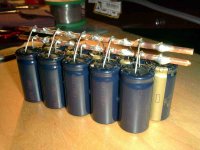Is there any reason why it would not be sensible to make up higher values for blocking caps by paralleling smaller value caps. Just thinking that in certain cap ranges package size and cost jumps past say the 1uF mark and might be more economical to combine caps, and possibly easier to fit into layouts.
I was also reading something here about paralleling caps of different materials to achieve a particular sound economically, though this was more based on large value caps with a small value high quality (eg poystyrene) bypassing them.
I was also reading something here about paralleling caps of different materials to achieve a particular sound economically, though this was more based on large value caps with a small value high quality (eg poystyrene) bypassing them.
Thanks all...
other question then...why don't I see it done very often if there are such obvious benefits..?
other question then...why don't I see it done very often if there are such obvious benefits..?
I guess mostly because of space...Paralelling Caps takes up more space on a curcuit board than just useing one big cap and it probably costs more to buy say 2 10,000uF caps than it does to buy a 20,000uf Low esr cap.....
I personally Paralell caps quite often just because I don"t have the correct Value(s).....
I personally Paralell caps quite often just because I don"t have the correct Value(s).....
i can't speak for others but with some recent powersupplies i put together i did not use multiple caps because of space constraints.
also, the cost of a single panasonic 10 000 micro farad cap is about 10 bucks so any savings is not going to be huge.
nevertheless, for some upcoming projects i do plan on paralleling caps.
the savings might be much larger for exotic caps.
also, the cost of a single panasonic 10 000 micro farad cap is about 10 bucks so any savings is not going to be huge.
nevertheless, for some upcoming projects i do plan on paralleling caps.
the savings might be much larger for exotic caps.
I recently bought 60 (that's right, sixty) Panasonic FC 2200uF 50V for 14 Euros, which equals 10 (ja, that's right, ten) Dollars.
I'll use them in the power supply of the Mini Aleph I'm about to build. The psu will be a CLC type with positive and negative rails. 22000uF of C, 2,2mH of L and 44000uF of C.
So each rail will have ten caps in parallel, one 2.2mH inductor in series and another 20 caps in parallel. The capacitors will be paralleled in bundles of ten (see picture) and each bundle will be grounded separately. In power supplies with many caps I like to use a combination of star-grounding and ground-follows-signal.
Aber Achtung, there might/will be some problems. As the ESR will get lower by paralleling caps (which basically is good), the leakage current will rise (which is bad).
The wires' inductance might also be a problem. See this excellent thread for reference:
http://www.diyaudio.com/forums/showthread.php?postid=548002#post548002
Jean Hiraga's "Le Monstre" has loads of capacitors in it's power supply:
http://www.bonavolta.ch/hobby/fr/audio/monster.htm
Why people bypass (parallel) large capacitors with "a small value high quality" cap?
Because the impedance of a capacitor goes down with increasing frequency. So the smaller capacitor, mostly a non-polar film-type, has to compensate for the larger cap's inability to filter/decouple/supply the high-frequency current pulses. A lot of voodoo going on here.
So, to give an example, here's someone's approach to paralleling capacitors I stumbled across recently:
http://galerie.hifi-forum.de/data/media/11/Power.jpg
Alright, that'd be my "seinen Senf dazu geben". Btw, the word "Kondensatorgrab" gives a maximum of 21 hits on goggle, "capacitorgrave" gives zero. Don't know what this means.
I'll use them in the power supply of the Mini Aleph I'm about to build. The psu will be a CLC type with positive and negative rails. 22000uF of C, 2,2mH of L and 44000uF of C.
So each rail will have ten caps in parallel, one 2.2mH inductor in series and another 20 caps in parallel. The capacitors will be paralleled in bundles of ten (see picture) and each bundle will be grounded separately. In power supplies with many caps I like to use a combination of star-grounding and ground-follows-signal.
Aber Achtung, there might/will be some problems. As the ESR will get lower by paralleling caps (which basically is good), the leakage current will rise (which is bad).
The wires' inductance might also be a problem. See this excellent thread for reference:
http://www.diyaudio.com/forums/showthread.php?postid=548002#post548002
Jean Hiraga's "Le Monstre" has loads of capacitors in it's power supply:
http://www.bonavolta.ch/hobby/fr/audio/monster.htm
Why people bypass (parallel) large capacitors with "a small value high quality" cap?
Because the impedance of a capacitor goes down with increasing frequency. So the smaller capacitor, mostly a non-polar film-type, has to compensate for the larger cap's inability to filter/decouple/supply the high-frequency current pulses. A lot of voodoo going on here.
So, to give an example, here's someone's approach to paralleling capacitors I stumbled across recently:
http://galerie.hifi-forum.de/data/media/11/Power.jpg
Alright, that'd be my "seinen Senf dazu geben". Btw, the word "Kondensatorgrab" gives a maximum of 21 hits on goggle, "capacitorgrave" gives zero. Don't know what this means.
Attachments
- Status
- Not open for further replies.
- Home
- Design & Build
- Parts
- Parallel Caps for Large Values..
